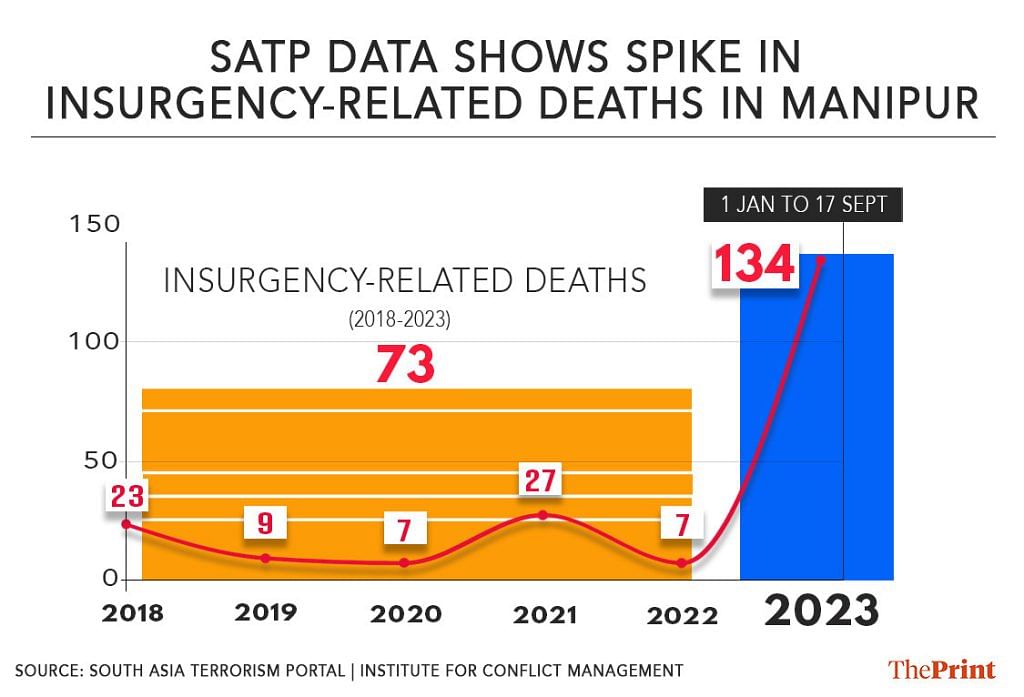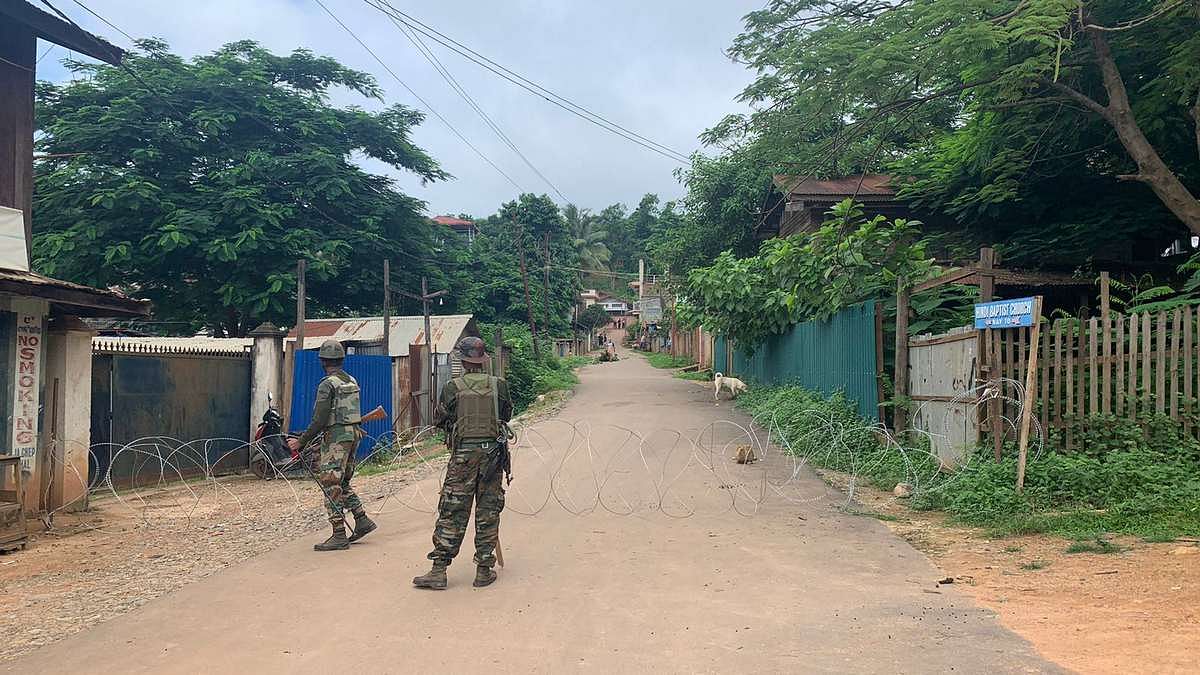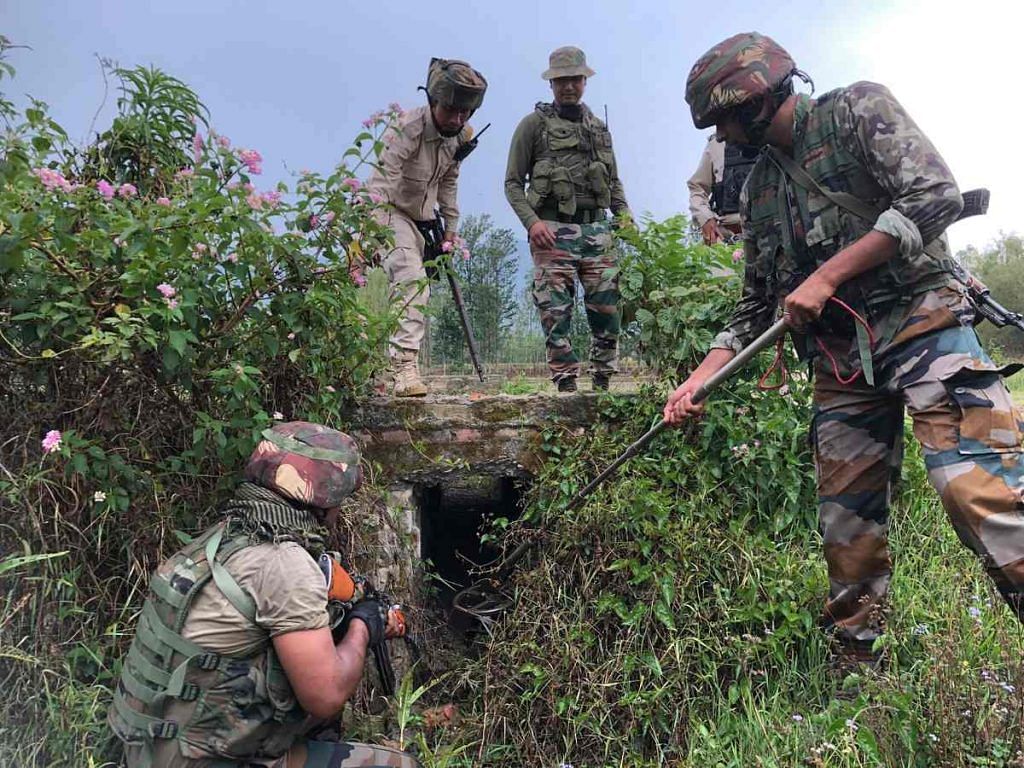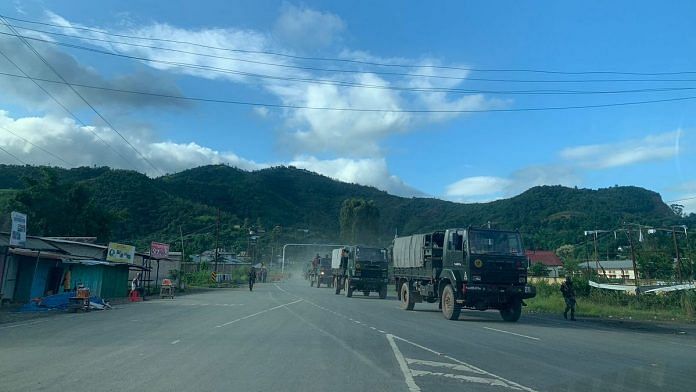Guwahati: The relentless ethnic conflict in Manipur between the majority Meitei population and the Kuki-Zomi tribals has taken an even darker turn. It has triggered a spate of organised clashes between armed insurgent groups, divided along ethnic lines, sources in the security establishment told ThePrint.
Deaths attributed to insurgency have reached a 10-year high, according to data from the Delhi-based Institute for Conflict Management (ICM), published on the South Asian Terrorism Portal (SATP).
As of 17 September, the portal listed 134 fatalities in insurgency-related incidents in Manipur, including 66 civilians, 53 insurgents, 14 armed personnel, and one unspecified casualty.
To put this in perspective, just seven insurgency-related fatalities were recorded last year. The cumulative toll for 2018-2022 was 73, including 32 insurgents and 16 security personnel.
However, most of the attacks this year have not been claimed by recognised insurgent groups. And government agencies are attributing the incidents of gunfights in the ethnic conflict to “armed or unidentified miscreants”.
Nevertheless, some experts claim all signs point to a revival in the activities of insurgent groups.
“Only trained insurgents can put up such a fight, not the local population. The Imphal valley had moved on long ago while the insurgents tried to gain prominence with an attack or two. But with the ethnic conflict, they have returned and have been accepted by the population — to an extent,” said a security analyst who did not wish to be named.

Over 80 percent of Manipur’s insurgent attacks and deaths were reported prior to 2010 with zero fatalities in the past five years across seven districts, including Imphal East, Imphal West, Senapati, and Ukhrul.
But now, the situation is different. Since the ongoing ethnic violence erupted on 3 May between the Meitei, predominantly based in the valley, and the Kuki tribes in the hill districts, 175 people have been killed and more than 1,100 injured across the state, Manipur police said last Wednesday. Unofficially, the figures could be higher.
This volatile scenario has reignited concerns regarding insurgency in the state, prompting appeals for peace accords, particularly with the valley-based insurgent groups (VBIGs).
Furthermore, the surge in violence has resurrected the debate surrounding the withdrawal of the ‘Disturbed Area’ status under the Armed Forces (Special Powers) Act (AFSPA) in the valley regions. Given that AFSPA remains a contentious topic, the clamour for its reinstatement in de-notified regions has given rise to allegations and counterarguments among civil society organisations.
The district-wise SATP data reveals that the highest casualties related to armed attacks this year have occurred in the valley’s Bishnupur district, with 51 deaths, including 28 ‘insurgents’, 20 civilians, and three security personnel. Next is Churachandpur, a hill district, which recorded 14 deaths, including 5 ‘insurgents’, 7 civilians, and two security personnel. The SATP mentions that the data has been compiled from news reports.
Bishnupur is among the areas in the valley from which the ‘Disturbed Area’ status under AFSPA has been withdrawn, while tribal-dominated Churachandpur, the epicentre of the conflict, remains under the jurisdiction of AFSPA.
As Kuki and Meitei groups exchange accusations of killings and violence, a debate is also arising over the steps that must be taken to prevent Manipur from returning to the days of insurgency and extortion.
Also Read: Murdered ex-Armyman’s 10-yr-old saw dad’s abduction in Manipur, gave chase: ‘I couldn’t do anything’
Insurgents active in both hills and valley
Insurgent groups are active in various parts of Manipur, operating in places that are both notified and de-notified as Disturbed Areas, according to local residents in hill as well as valley areas who spoke to ThePrint.
These groups are reported to have become participants in the ongoing ethnic conflict within the state.
On the Kuki side, insurgents from various factions have reportedly joined hands with village defence forces that have organised into combat groups.
Meanwhile, on the Meitei side, reports indicate that insurgents have returned from Myanmar and are actively resisting the Kuki-Zomi demand for ‘separate administration,’ allegedly with the backing of certain civilian groups.
However, former Manipur police chief and ex-deputy CM Yumnam Joykumar Singh, indicated that such reports were yet to be verified.
“There’s a thin line between who is a militant and who’s not. Let the state and central security forces act as per the law, and against all armed militant groups in Manipur,” he told ThePrint.
According to him, AFSPA holds “no relevance in the conflict,” as it is only required to target insurgents.
“The gunfights have not happened within the Imphal municipality area (from where Disturbed Area status has been withdrawn),” he added.
But security sources told ThePrint that Meitei insurgents from proscribed outfits under the Coordination Committee (CorCom), a conglomerate of VBIGs, have returned to the state.
The CorCom includes the People’s Revolutionary Party of Kangleipak (PREPAK) and its Progressive faction (PREPAK-Pro), Revolutionary People’s Front (RPF)— the political wing of the People’s Liberation Army (PLA), and the United National Liberation Front (UNLF).
Other groups like the Kangleipak Communist Party (KCP) and Kanglei Yawol Kanna Lup (KYKL), which were earlier part of CorCom, have also allegedly entered the scene.

Notably, in an 11 September PTI report, security officials were cited as claiming that insurgents from banned groups like the “UNLF, PLA, KYKL and PREPAK” were part of a mob from where shots were fired, severely injuring an Army officer on 8 September in Tengnoupal district.
On 24 June, the Army was forced to release 12 KYKL cadres, who had been detained in Imphal, after a standoff with Meira Paibis (Meitei women vigilantes).
One of the men was KYKL leader Moirangthem Tamba, also known as Uttam, who played a key role in the 2015 ambush on the 6 Dogra regiment, resulting in the deaths of 18 soldiers.
On 6 September, a team of Assam Rifles at Moreh, acting on inputs from a Military Intelligence Unit, apprehended an “active cadre” of the proscribed PLA along the Indo-Myanmar border, while he was “attempting to cross the border”. He was handed over to Manipur Police.
#AssamRifles in #Manipur apprehend an active PLA cadre, along the Indo-Myanmar border near #Moreh, attempting to cross the border. The individual has been handed over to @manipur_police.@SpokespersonMoD @DiprManipur @official_dgar @PIBImphal pic.twitter.com/N6WHH3SW3U
— PRO Defence, Manipur, Nagaland & South Arunachal (@prodefkohima) September 7, 2023
The man was later identified as the self-styled “lieutenant” Shanti Yumnam of Imphal East, who was part of the PLA’s leadership group stationed at its headquarters in Myanmar.
“The insurgents know that they can never return to their homeland if they do not listen to the cries of the people now,” said Yambem Laba, veteran journalist and social activist in Imphal. “The government must find an honourable solution to the issue by bringing all Meitei armed groups to the negotiating table. There should be a suitable environment and trust.”
‘Wild West scenario’
Civilian sources from both hill and valley regions have reported that “insurgents are active” in various locations near the foothills.
While 25 armed Kuki groups affiliated with the Kuki National Organisation (KNO) and the United People’s Front (UPF) had signed a Suspension of Operation (SoO) agreement with the central and state governments in 2008, there are concerns they are no longer dormant.
Following the clashes in May, questions have arisen regarding the involvement of Kuki armed factions and their adherence to the SoO agreement, as well as the large-scale looting of weapons from state armouries in the valley and hill areas.
Since the conflict began, 5,668 weapons have been looted from police armouries along with 6.6 lakh rounds of ammunition and 14,825 bombs, Manipur Police said in its Wednesday statement.

So far, security forces have successfully recovered 1,329 weapons, 15,050 rounds of ammunition, and 400 bombs in ongoing operations.
“The guns could be floating around for many more years, and that may lead to a ‘Wild West’ scenario, if not recovered,” said Laba.
Extortion on the rise?
The violence in Manipur has allegedly led to a spike in extortion demands by insurgent groups and their overground operatives in both valley and hill areas.
Sources in Imphal, for instance, said ransom notices were served to shopkeepers by banned outfits PREPAK, UNLF, KCP, PLA and other terror groups that arm themselves through extortion in their respective areas.
In the hills, groups such as the United Kuki Liberation Front (UKLF), Kuki National Army (KNA), Zomi Revolutionary Army (ZRA), and smaller outfits are allegedly demanding money from non-locals, intelligence sources told ThePrint.
There has also been an uptick in recruitment in all insurgent camps across hills and the valley, the intelligence sources added.
‘Fragile situation in de-notified areas’
The law-and-order situation is “fragile in de-notified areas”, according to a security source.
Out of the 367 individuals arrested in the past six months, a significant majority — 277 people —were apprehended from the de-notified areas within the valley.
In joint operations conducted by security forces across the state from 1 April to 10 September, a total of 16 insurgents, seven traffickers, and 254 armed protestors were apprehended from de-notified areas, the source added.
In the past year, the source further claimed, 28 low-intensity blasts occurred within de-notified areas of the valley, mostly linked to cases of extortion.
In comparison, during the April-September period, 90 individuals were arrested in the hill areas where AFSPA remains in effect, and none of these instances involved insurgents, the source claimed.
While the specific number of First Information Reports (FIRs) for incidents of arson and killings in both notified and de-notified areas could not be independently confirmed, over 9,300 FIRs have been filed in the state since the outbreak of violence on May 3.
Calls for AFSPA over ‘insurgents’
Civil society organisations from the Kuki and Meitei communities have taken opposing stances on the implementation of AFSPA.
The Committee on Tribal Unity (CoTU) Sadar Hills, a prominent tribal organisation, has called for the re-imposition of AFSPA in the valley areas, particularly following the killing of three Kuki-Zo village volunteers in Kangpokpi district early on 12 September.
However, the Coordinating Committee on Manipur Integrity (COCOMI), representing valley-based civil society organisations, released a statement last Wednesday, dismissing the demand from Kuki CSOs as “illogical.”
Their statement claimed that ransom demands and killings have been primarily occurring in “Kuki-dominated areas”. It also alleged that the areas with the highest violations of law and order coincided with the locations of Suspension of Operations (SoO) camps for Kuki insurgents.
But there have been counter-allegations too.
On 13 September 13, the Indigenous Tribal Leaders’ Forum (ITLF), a coalition of recognised Kuki-Zomi tribes, strongly condemned the killing of Onkhomang Haokip, a Manipur Police sub-inspector stationed at a buffer zone between Bishnupur and Lamka (Churachandpur). According to the ITLF press release, a “sniper affiliated with a valley-based insurgent group” fatally shot the sub-inspector, who belonged to the Kuki-Zo community.
The release added: “All recent killings of Kuki-Zo tribals in Manipur can be attributed to well-trained Meitei separatists. Therefore, we urge the central government and central security forces to take decisive action against VBIGs.”
Meanwhile, some residents in the foothill villages between Churachandpur and Bishnupur districts told ThePrint that they could easily identify members of VBIGs in the area.
“They have operated in tribal-dominated areas for more than 20 years, so it’s not difficult to identify them,” said Mang, a resident in a foothill village. “Those trained to fire a bullet can be distinguished from the untrained ones.”
Also Read: Ethnicity was manipulated to control Manipur insurgency–the hate this unleashed set it on fire
Conflicting views
AFSPA can only be enforced in areas designated as ‘Disturbed Areas,’ which is a decision made jointly by the central and state governments.
On 9 September, the Manipur cabinet reportedly approved the extension of the “disturbed area” designation under AFSPA for another six months, excluding municipal areas of Imphal and regions within the jurisdiction of 19 police stations.
There has, however, been no official notification confirming this decision.
In April 2022, the Disturbed Area status was removed from 15 police station areas in six valley districts. In March 2023, four police stations were added to the list based on the Union government’s assessment of an “improved security situation” in the Northeast. These new additions included Wangoi police station in Imphal West district, Leimakhong in Kangpokpi, and Nambol and Moirang police stations in Bishnupur.
In its 24 March notification, the state home department cited the Governor of Manipur’s opinion that “violent activities of insurgent groups warrant the use of armed forces in the aid of civil administration in the entire state, except the areas falling under the jurisdiction of 19 police stations”.
These excluded police stations are located in Imphal, Thoubal, Bishnupur, Moirang, and Kakching, areas that have witnessed significant unrest, especially in peripheral villages between valley and hill districts.
In the rest of the state, AFSPA grants the armed forces the authority to “use force, even to the causing of death,” against those suspected of violating the law, engaging in armed conflict, or posing an imminent threat.
Some Kuki-Zo leaders argue that the withdrawal of AFSPA from valley areas and the absence of military support have worsened the conflict. But others from the Meitei community contend that the continued imposition of AFSPA in the valley would have led to further bloodshed.
Speaking to ThePrint, author and historian Malem Ningthouja said that AFSPA is not the solution.
“A riot is a riot, with or without the AFSPA. The current round of violence and escalation of insurgent activities are due to political fault lines. It has to be politically addressed,” Ningthouja said.
“When the violence broke out, central forces were deployed. Could it help stop the violence? Will the army be in a position to shoot down everybody? Military and police follow orders from higher authority,” he added.
AFSPA has been routinely extended every six months, with the state government assessing the security situation.
But Ningthouja argued that it had failed to quell insurgency in Manipur and had become a symbol of oppression and rights abuse.
“AFSPA is a politically designed restraint mechanism to deal with insurgency at a time when state police was considered not sophisticated enough to handle it. But AFSPA nowhere has stopped insurgency in Manipur. Post AFSPA, Manipur has seen a rise of insurgent groups,” Ningthouja said.
“The Indian think tanks and official recommendations had sought for repeal of AFSPA, and that is why disturbed area tags have been removed from certain places. The government should look out for progressive mechanisms to create an environment where insurgency becomes redundant,” he added.
The revocation of AFSPA from particular areas means that the armed forces moving through these places for administrative and logistical purposes can still use security for protection, but cannot launch counter-insurgency operations, defence sources had earlier told ThePrint.
All such operations instead will be undertaken by the state police, and the Army will operate “only when requested or requisitioned by the civil administration”.
However, intelligence collection and sharing will continue even for de-notified areas, the government sources had clarified.
Lost trust between civilians & military
Over years, allegations of fake encounter killings have been levelled against the Indian Army, the paramilitary force Assam Rifles, and Manipur Police commandos, with more than 1,528 such cases reportedly occurring in the state between 2000 and 2012.
Building trust between the forces and the local population in Manipur has remained a challenge. Despite some progress made in the past decade, the present conflict has rapidly exposed fault lines.
The situation is made worse by the alleged differences between the Assam Rifles and the Manipur police commandos, the latter largely comprising Meiteis. The two forces deployed in the foothills have exchanged heated arguments on certain occasions.
Differences also cropped up over the standard operating procedures (SOPs) during combing operations in de-notified areas to recover snatched weapons and ammunition — in the presence of magistrates. Locals from both communities allege that the two forces have rarely remained neutral actors in the ethnic conflict.
In June, the COCOMI announced its resolution to “not allow military operations by security forces in the valley areas”.
“The people who want law and order restored would want AFSPA to be brought back in the valley areas, because police is near non-functional here,” said Lalam Hangshing, general secretary of the Kuki People’s Alliance, a political party formed during the 2022 Manipur assembly elections.
“The miscreants in the valley have no fear because no one would arrest them, or even conduct proper checks,” he added.
Notably, amid such criticism, on 18 September, Manipur Police took to Twitter highlighting the legal action it took against “anti-social elements” in view of “extortion threats, misuse of police uniform, and impersonation by armed miscreants”.
Strict Legal Action Taken up against Anti-Social Elements by Manipur Police:
There have been protests today as well against the arrests of 05 (five) persons at Porompat PS on 16.09.2023. It may be recalled that in view of extortion threats, misuse of police uniform and…
— Manipur Police (@manipur_police) September 18, 2023
Police stated that five persons, dressed in camouflage and carrying sophisticated weapons were arrested Saturday and later remanded to police custody. The arrests sparked outrage among the public with protesters storming the Porompat police station. Local groups called for a 48-hour bandh across Imphal valley beginning Tuesday, demanding the unconditional release of the five men.
Why AFSPA?
Human rights activist Babloo Loitongbam contends that if the Army deems it necessary to invoke AFSPA, it should be done with a strong focus on human rights.
While Loitongbam has advocated for AFSPA’s repeal from the entire state, he said “if our Kuki brothers favour AFSPA in their area, then so be it”.
He clarified: “It is purely to assist the civil administration that AFSPA is imposed. With the withdrawal of DA status from Imphal valley areas, the police can operate and take charge. There is a slim presence of Manipur police in the hills, the ethnic composition in the police force is also a factor.”
According to him, even if AFSPA is imposed in the hill districts, the central forces are not using provisions under the Act during the conflict situation.
“Even without AFSPA, under Section 133 CrPC, the central armed forces can operate and conduct flag marches. Have they done it in the hill areas when required?” he asked.
Meanwhile, Ningthouja said that there can be military deployment and counter-insurgency operations without AFSPA.
“Countless people have been killed in the valley by Manipur police in counter-insurgency operations. It is the state force that has nothing to do with AFSPA that carried out maximum killings and arrests,” he said.
On the other hand, KPA general secretary Hangshing claimed that the imposition of AFSPA did not significantly affect the Kuki community since Kuki armed groups were “not secessionists”.
“Since the early 90s, the Army has not come into conflict with Kuki armed groups, which were formed around that time to protect the community from the Naga rebels. AFSPA in the hills was necessary to contain the Naga insurgents,” he claimed.
In the early 1990s, the National Socialist Council of Nagalim-Isaak Muivah (NSCN-IM) allegedly carried out a series of ethnic cleansing campaigns against the Kukis in Manipur. This led to the formation of several Kuki armed outfits in retaliation.
The overlapping territorial claims of the Nagas and Kukis have been a source of tension and conflict for decades. But ahead of the observance of “Sahnit Ni” (Kuki Black Day) on September 13, the KPA appealed to the Naga community in Manipur to come together for “all-Manipur Tribal unity”. The Kuki chiefs and civil societies in Kangpokpi also decided to not display black flags on the occasion. The KPA termed it a gesture to “bury the past” for “future peace and development”.
Despite these overtures, an NSCN-IM Deputy Kilonser (cabinet minister) said that Nagas and Kukis can only come together under the umbrella of Christianity, and not under any political ambition or ideology. “There’s no chance for tribals to come together because we cannot change history, we are culturally different, and ideologically set apart,” he said.
‘We cannot let Manipur go back…’
Former police chief Y Joykumar said there can be no solution “if gunfights are allowed to continue.”
“The Army and Assam Rifles should remain neutral in their role and act equally against both Kuki and valley-based armed groups. The state police has acted against Meitei militants in the past,” he added.
Joykumar also underscored the importance of preventing Manipur from regressing to the days of insurgency.
“We cannot let Manipur go back to earlier days of insurgency. It is important to bring all Meitei militant factions to the negotiating table and have a dialogue, some solution in the form of ceasefire or Suspension of Operations. You will have to convince them,” he said.
One of the biggest challenges confronting Manipur has been the threat of cross-border infiltration from Myanmar, where several insurgent groups have found a safe haven.
Rebel camps are reportedly located on the southern side of the thickly forested border and further north near Moreh and Tamu.
Over the years, the armed forces have conducted multiple counter-insurgency operations throughout the state, but amid the current ethnic conflict, even the gains from these appear to be at some risk.
(Edited by Asavari Singh)
This report has been updated to reflect the current constituents of CorCom.






